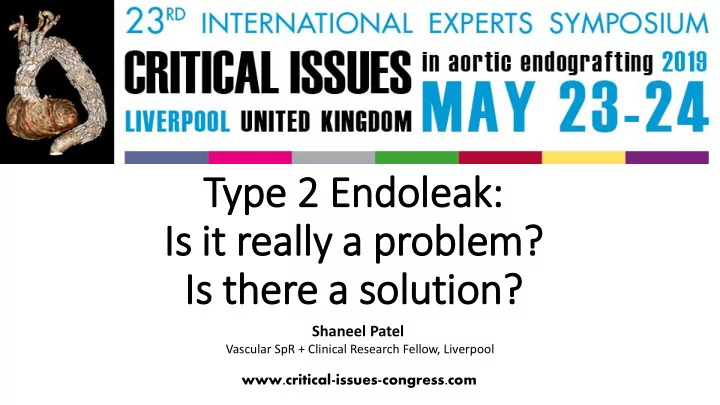

Type 2 Endoleak: Is Is it really a problem? Is Is there a solution? Shaneel Patel Vascular SpR + Clinical Research Fellow, Liverpool www.critical-issues-congress.com
Disclosures - Nil
EVAR has significant re-intervention rate EVAR 1 midterm analysis, NEJM 2010 Causes of re-intervention after EVAR in a cohort of 558 patients Al-Jubouri et al, Ann Surg 2013;258:652 – 658
Critical Issues around Type II Endoleaks How common are they now? Are they really a problem? Which interventions can we offer? Do these interventions work?
Incidence of type II Endoleaks UK EVAR randomised controlled trials: long-term follow-up and cost-effectiveness analysis Patel et al, HTA Assessment Jan 2018; Vol.22;No.5 No. of Type II Endoleaks % (no of patients followed up) EVAR - 1 146 (1252) 11.7 OVER 139 (881) 15.8 DREAM 73 (351) 20.8 ACE 77 (299) 25.8
British Journal of Surgery 2013; 100:1262-1270 32 studies published between 1994 and 2012 1515 T2ELs in 14,794 patients = 10.2% 35% resolve spontaneously
EJVES 2014 48;4:391-399 Local series of consecutive EVARs n = 904 1995 - 2013 Median follow-up 3.6 years (1.5-5.9) Multivariate analysis – No independent RFs for T2ELs Number of T2ELs = 175 (19%) T2EL is NOT a graft-related problem, 54% self-resolved within 6 months it is an inherent failure of the EVAR concept
Critical Issues around Type II Endoleaks How common are they now? 10-25% of all EVAR. Up to 50% self-resolve. Are they really a problem? Which interventions can we offer? Do these interventions work?
Wyss et al, Annals of Surgery 2010, 252(5), 805-812 “Previous complications” on CT increased the risk of rupture EVAR 1 and EVAR 2 cases combined adjusted HR 8.83 (95% CI 3.76-20.76) P<0.0001 n=848 “Previous complications” = Cluster of: Mean f/u – 4.8yrs - Type 1 EL Type 2 + aneurysm expansion (≥5mm) - 27 ruptures after EVAR - Type 3 EL - Migration - Kinking
EJVES 2004; 24,128-137 EUROSTAR registry T2Els associated with: - Aneurysm expansion (114 European Institutions) 1996-2002 T2ELs NOT associated with: - Rupture 3595 EVARs - Aneurysm-related mortality 320 isolated T2Els (9%) 1.2% rupture rate at 3 years
J Vasc Surg 2015, 62(3), 551-561 T2ELs treated conservatively: US Registry data No difference between: - sac growth group 2000-2010 - no sac growth group 1736 patients, 3 yr f/u For overall survival 474 T2ELs (27.3%) 0 ruptures with isolated T2EL
British Journal of Surgery 2013; 100:1262-1270 Rupture in cases of isolated type II EL 32 studies published between 1994 and 2012 <1% 1515 T2ELs in 14,794 patients = 10.2% (57% of these T2EL cases were associated with aneurysm expansion) 35% resolve spontaneously Aneurysm expansion is a poor marker of risk with Type II EL
Critical Issues around Type II Endoleaks How common are they now? 10-25% of all EVAR. Up to 50% self-resolve. Are they really a problem? Largely no. Difficult to predict rupture. Which interventions can we offer? Do these interventions work?
Endovascular Vessel ligation embolization Open Conversion Open or Lap (coils/glue/thrombin) Trans-Lumbar access (direct aneurysm puncture)
Endovascular Vessel ligation embolization Open Conversion Open or Lap (coils/glue/thrombin) Trans-arterial access (SMA/Internal Iliac)
Endovascular Vessel ligation embolization Open Conversion Open or Lap (coils/glue/thrombin) Trans-caval access
Endovascular Vessel ligation embolization Open Conversion Open or Lap (coils/glue/thrombin) Trans-seal access
Critical Issues around Type II Endoleaks How common are they now? 10-25% of all EVAR. Up to 50% self-resolve. Are they really a problem? Largely no. Difficult to predict rupture. Which interventions can we offer? Endovascular and Open. Do these interventions work?
J Vasc Surg 2015, 62(3), 551-561 T2ELs treated conservatively: US Registry data No difference between: - sac growth group 2000-2010 - no sac growth group 1736 patients, 3 yr f/u For overall survival 474 T2ELs (27.3%) 0 ruptures with isolated T2EL
In patients with isolated T2EL and aneurysm size increase: Reintervention group versus No reintervention: - Equivalent survival (p=0.57) J Vasc Surg 2015;62(3):551-561
JEVT 2012 19(2), 200-208 Meta analysis No difference between groups for : 10 studies and 231 isolated T2ELs - Reducing sac expansion Grouped: - Increasing sac regression 1) Conservative management, n=71 2) Selective treatment, n=104 Incidence of rupture 0% (>5mm sac expansion, persistence beyond 6 months) (median f/u 30 months) 3) Aggressive n=56 (any T2EL)
EJVES 2018 56(6), 794-807 59 studies 1073 patients with persistent type II EL who underwent intervention Majority (73.8%) of cases were for aneurysm expansion Presented outcomes of different treatments individually
Ultee et al EJVES 2018 56(6), 794-807 Intervention Primary technical success (%) Overall 87.9 Transarterial embolization 84.0 Translumbar embolization 98.7 Transcaval embolization 93.3 Ligation of vessels (Surgical) 98.1 Cases Clinical success (%) – f/u range 6-46/12 Overall 68.4 As defined by decreasing/stable aneurysm size 78.4 As defined by no leak on scanning 67.5 *Peri-procedural complication rate of 4%* *AAA-related mortality after intervention for Type II Endoleak is 1.8%*
Critical Issues around Type II Endoleaks How common are they now? 10-25% of all EVAR. Up to 50% self-resolve. Are they really a problem? Largely no. Difficult to predict rupture. Which interventions can we offer? Endovascular and Open. Do these interventions work? Not very well, although currently we’re not using relevant measures of success and we don’t have long -term data.
Wanhainen et al 2019 EJVES 57,8-93 THIS IS TOO AGGRESSIVE Let’s leave ALL isolated T2ELs with aneurysm expansion alone (Closely monitor for Type I and III endoleaks)
Thank you
Recommend
More recommend